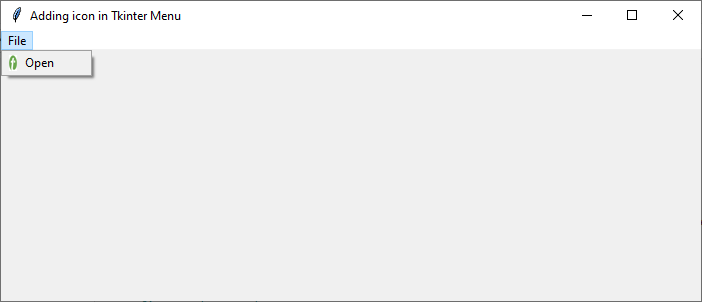
 Data Structure
Data Structure Networking
Networking RDBMS
RDBMS Operating System
Operating System Java
Java MS Excel
MS Excel iOS
iOS HTML
HTML CSS
CSS Android
Android Python
Python C Programming
C Programming C++
C++ C#
C# MongoDB
MongoDB MySQL
MySQL Javascript
Javascript PHP
PHP
- Selected Reading
- UPSC IAS Exams Notes
- Developer's Best Practices
- Questions and Answers
- Effective Resume Writing
- HR Interview Questions
- Computer Glossary
- Who is Who
Is it possible to have icon in Tkinter menubar in Python?
Tkinter is a popular GUI (Graphical User Interface) toolkit for Python that provides developers with a set of tools and widgets to create desktop applications. It is widely used due to its simplicity and ease of use. When it comes to designing user-friendly applications, having an intuitive and visually appealing interface is essential. One aspect of GUI design that can greatly enhance the user experience is the use of icons. Icons provide visual cues and make it easier for users to navigate through menus and perform actions. In this article, we will explore whether it is possible to have icons in Tkinter menubar in Python.
Tkinter offers a range of standard widgets, including buttons, labels, entry fields, and menus. Menus in Tkinter are typically used to provide a set of options for users to choose from. The menubar is a container widget that holds one or more menus. By default, Tkinter menus are text-based, which means they display menu options as plain text. However, there is no built-in support for adding icons to menu items in Tkinter.
Nevertheless, there are ways to work around this limitation and achieve the desired outcome. One approach is to use third-party libraries or extensions that provide additional functionality to Tkinter. One such library is Pillow, which is a powerful image processing library for Python. With Pillow, we can load image files and display them in Tkinter applications.
To add icons to the Tkinter menubar, we need to follow a series of steps. First, we need to create an image object from the desired icon file using the Pillow library. Then, we can use the ImageTk module, which is a Tkinter-compatible wrapper for Pillow, to convert the image object into a Tkinter-compatible image. Finally, we can associate the image with the menu item by specifying it as the image parameter.
Example
Let's take a look at an example to illustrate this process
import tkinter as tk
from PIL import Image, ImageTk
def open_file():
print("Opening file...")
# Create the Tkinter root window
root = tk.Tk()
root.title("Adding icon in Tkinter Menu")
root.geometry("700x250")
# Create a menubar
menubar = tk.Menu(root)
# Create a file menu
file_menu = tk.Menu(menubar, tearoff=0)
# Load the icon image
icon_image = Image.open("C:\Users\Leekha\Desktop\tp.png")
# Resize the image if necessary
icon_image = icon_image.resize((16, 16))
# Convert the image to a Tkinter-compatible format
tk_icon = ImageTk.PhotoImage(icon_image)
# Add a menu item with an icon
file_menu.add_command(label="Open", image=tk_icon, compound="left", command=open_file)
# Add the file menu to the menubar
menubar.add_cascade(label="File", menu=file_menu)
# Configure the menubar
root.config(menu=menubar)
# Start the Tkinter event loop
root.mainloop()
In this example, we start by importing the necessary modules: tkinter for the GUI elements and Image and ImageTk from Pillow for working with images. We define a simple function open_file() that will be called when the "Open" menu item is clicked.
Next, we create a Tkinter window and create a menubar using the Menu widget. We also create a file menu using the Menu widget and associate it with the menubar using the add_cascade() method.
To add an icon to the "Open" menu item, we first load the icon image using Image.open(). We can also resize the image if necessary using the resize() method. Then, we convert the image to a Tkinter-compatible format using ImageTk.PhotoImage(), which creates a Tkinter-compatible image object.
Finally, we add the menu item to the file menu using the add_command() method. We specify the label text as "Open", set the image parameter to the Tkinter-compatible image object we created earlier, and use the compound parameter to position the icon on the left side of the menu item text. We also specify the command parameter to associate the open_file() function with the menu item.
Output
By running this code, we can see that the Tkinter menubar now displays an icon alongside the "Open" menu item.

Conclusion
In conclusion, although Tkinter lacks built-in support for icons in the menubar, it is still possible to incorporate icons using third-party libraries like Pillow. By utilizing Pillow to load and convert image files into a Tkinter-compatible format, we can successfully associate icons with menu items in Tkinter applications.
This capability enables developers to design visually appealing and user-friendly interfaces that significantly enhance the overall user experience. By leveraging the power of external libraries, Tkinter can overcome its icon limitations and offer a more engaging and intuitive graphical interface for Python applications. With a little extra effort and the right tools, developers can create impressive and professional-looking GUIs with icons in Tkinter.

